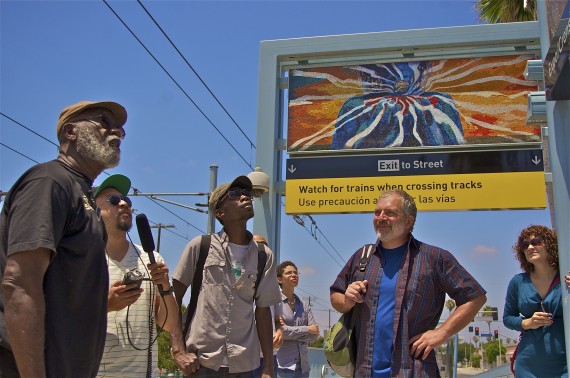
Have you ever stood in front of a piece of public art and thought your experience would be all the awesomer if you had some context for the work? Or maybe you passed by a public artwork every day and it didn't register with you until someone engaged you on questions of its value and meaning?
With those questions in mind, members of the Ride South L.A. team (Francois Bar, Tafarai Bayne, George Villanueva, and Benjamin Stokes), Ben Caldwell (of the Kaos Network in Leimert Park), and I thought it might be interesting to see how people were experiencing some of the work at the new stops along the Expo Line.
We decided to make a site-specific recording that offered an insider's perspective on the art and the artist. We figured that once the recording was completed, we could then leave strategically-placed stickers with a brief blurb about the project and a phone number at the site for people to call. Callers would not only be able to hear the recording, but they would also have the option to record their own impressions of and responses to the work.

As our test site, we chose the work of late artist Willie Middlebrook at the Crenshaw stop. Middlebrook was one of ten artists Metro commissioned to create a total of 176 original works celebrating the communities along the route.
Ben Caldwell, a friend and contemporary of the artist who had been involved with the art selection committee, told us that Middlebrook had been a shoe-in for the commission from the start. Even though a number of other well-funded artists had applied, the sheer power of Middlebrook's work and its uplifting reflection of the historically Black community -- what Caldwell called a "cauldron of artistic power" -- seemed to have resonated with the committee.

Middlebrook "flew through" the selection process once the committee saw the work, he said.
As we stood discussing Middlebrook's rich mosaics depicting themes of connectivity between humans and the earth and among diverse populations, people waiting for the train gathered around us.
I approached a young man with headphones who hovered nearby while attempting to appear disinterested. He pretended not to hear me speaking to him until I mentioned Middlebrook's connection to Watts.
"Watts?" he asked, turning toward me with a surprised look. "Did he have something to do with building the Watts Towers?"
"No," I answered, explaining that Middlebrook had worked from Watts and had always sought to portray African Americans with the dignity and integrity that others did not always grant them.
"Cool," he nodded, recovering his too-cool-for-school demeanor. "Cool."

I returned to the group and the conversation with Caldwell to see that more passengers-to-be had drawn nearer. They followed our gaze up to the mosaics, then off across the street to the West Angeles Church (whose beautiful stained glass colors the mosaics mirror), before turning back to hear more from Caldwell.
Their interest was heartening to the group. It seemed to underscore the importance of creating art that was both publicly accessible to people and reflective of the surrounding community. It also appeared to signal that simply putting public art in place was not always enough to make observers embrace it or help them experience its deeper meaning. There is value, in other words, in taking extra steps to help people connect to the art put there for their benefit.
Now, we just hope Metro will feel the same and allow us to promote the project with informational stickers at its stops once the recording is ready. Stay tuned...






